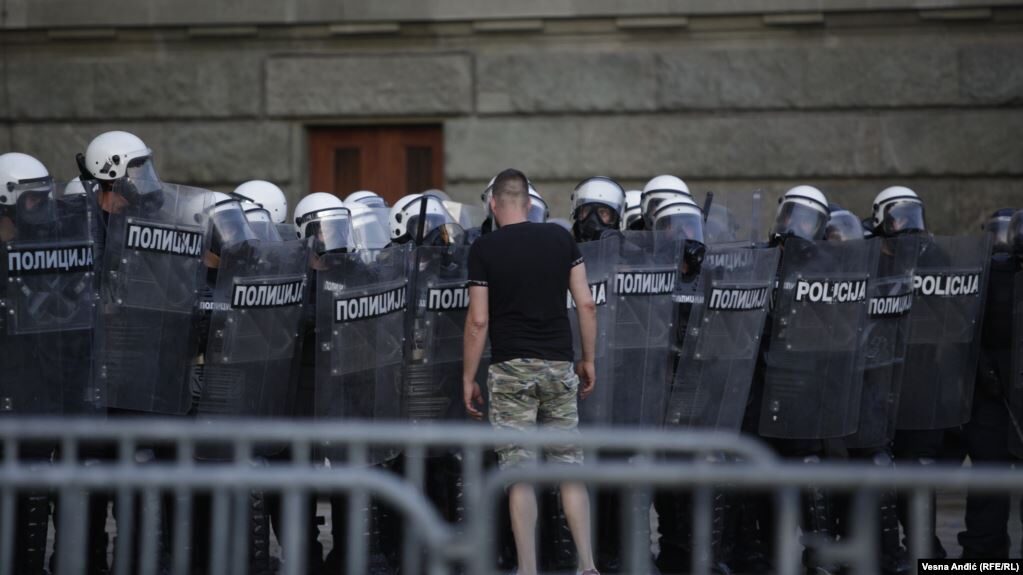Prime Minister Ana Brnabic said on July 9 that there will be a ban on organized public gatherings of more than 10 people in the capital, both indoors and outdoors.
Despite the ban, protesters began gathering for a third night in front of the Serbian parliament in Belgrade. Most of them sat on the sidewalk outside the national assembly in order to differentiate themselves from those who may engage in violence.
Among the other measures announced by Brnabic are observing social-distancing rules when indoors and restrictions on indoor facilities that will ban people from working between 9 p.m. and 6 a.m., while open spaces such as parks will be closed from 11 p.m. to 6 am.
Brnabic explained that the measures are only for the capital, where the situation is most critical and where police used tear gas to disperse a protest that lasted well after nightfall on July 8 outside parliament.
"We no longer have the hospital capacity to receive patients in Belgrade. We will pay the price for what happened last night and the day before (protests), and we are yet to see those people who became infected there. We will see that in the next 5, 6, 10 days," she said.
Comment: If the massive protests in America are anything to go by, then numbers of infected may spike but the death rate won't.
Brnabic said that, even though imposing a curfew would be more effective, officials dropped the idea to "take an intermediate step for the sake of the economy and the citizens."
Protests have spread to Serbia's second-largest city, Novi Sad, where demonstrators on July 8 tried to storm a building that houses the regional public broadcaster.
As the crowd marched in Novi Sad some people hurled stones and other objects at the city hall building, where a fire broke out. Protesters also threw stones at the office of the ruling Serbian Progressive Party (SNS).
The demonstrations in Belgrade erupted on July 7 after President Aleksandar Vucic announced new mandatory distancing steps and his intention to impose the curfew.
Mounting Frustration
Belgrade has been on edge amid mounting frustration at the government's latest response to a resurgent coronavirus outbreak and the perceived politicization of the team leading efforts to stem the danger to public health in the Balkan state.
Deputy Prime Minister Nebojsa Stefanovic called the protest illegal because it had not been registered and said it was only about violence, not state policy. He said 10 police officers had been injured on July 8, including one whose legs were broken when he was pushed down a flight of stairs.
The protest on July 7 turned violent when a group of protesters broke into the parliament building while others threw stones, bottles, and other projectiles at police, prompting officers to fire tear gas to disperse the crowd.
Amnesty International condemned the use of violence.
"Serbian authorities must exercise restraint in further protests and the government must guarantee the safety and security of those who take the streets and ensure that people can exercise their right to demonstrate peacefully and without fear of reprisals," the rights watchdog said in a July 9 statement.
Vucic has called on Serbs to avoid protests because they threatened to worsen the coronavirus epidemic, which has officially infected more than 17,000 people in Serbia, killing 341 of them.
The government has ramped up anti-pandemic measures amid a COVID-19 spike since rapidly reopening before June 21 elections won by Vucic and his ruling SNS allies.
The global coronavirus pandemic and the pathogen's arrival in Serbia in March prompted a strict lockdown that interrupted over a year of weekly antigovernment demonstrations.
Those protests targeted Vucic's tightening grip on media and the levers of power amid a spate of attacks on journalists and other government critics in the Balkan country of around 7 million people.
Demonstrators also want Serbian public broadcaster RTS to report objectively on the situation in the country.




The fact the PTB have folded above proves it; as does their continuing to allow 'governmentally /PC approved 'protests' (riots) while maintaining lockdowns for the rest of us.*
NOW, we need to wake folks up and SHUT DOWN THE LOCKDOWNS!
R.C.
*See, e.g.,
NYC mayor bans 'large events' through end of September - except BLM protests
New York Mayor Bill de Blasio has banned all large public events for the next three months, citing the Covid-19 pandemic - only to make a belated exception for Black Lives Matter rallies,...RC